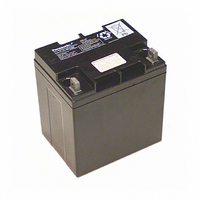LC-X1228P Panasonic - BSG, LC-X1228P Datasheet - Page 13

LC-X1228P
Manufacturer Part Number
LC-X1228P
Description
BATT SEALED LEAD ACID 12V 28AH
Manufacturer
Panasonic - BSG
Series
LCr
Datasheet
1.LC-X1228AP.pdf
(67 pages)
Specifications of LC-X1228P
Voltage - Rated
12V
Capacity
28Ah
Size / Dimension
6.47" L x 4.92" W x 6.89" H (165mm x 125mm x 175mm)
Termination Style
Nut/Bolt, M5
Rechargeability
Yes
Weight
25 lbs (11.3kg)
For Use With
BVW122250003N - BATTERY CHG UNIV 12VDC @ 2.25A271-2390 - BATTERY CHG UNIV 12VDC @ 2.25A271-2386 - BATTERY CHG UNIV 12VDC @ 1.2A271-2385 - BATTERY CHG UNIV 12VDC @ 600MA271-2382 - BATTERY CHG UNIV 12VDC @ 500MA271-2381 - BATTERY CHG UNIV 12VDC @ 500MA271-2380 - BATTERY CHG 120VAC 12VDC @ 500MA271-2378 - BATTERY CHG 120VAC 12VDC @ 300MAPATC-08 - BATT CHARGER 12V 1.5A X 2 UNITPATC-03 - BATTERY CHARGER 12 VOLT 1.5 AMP
Lead Free Status / RoHS Status
Contains lead / RoHS compliant by exemption
Other names
LC-X1228
LC-XB1228
LC-XB1228P
LCX1228P
P049
LC-XB1228
LC-XB1228P
LCX1228P
P049
GENERAL INFORMATION ON VALVE-REGULATED LEAD-ACID BATTERIES
Construction and Electrolyte
Positive plates are plate electrodes of which a grid
frame of lead-tin-calcium alloy holds porous lead
dioxide as the active material.
Negative plates are plate electrodes of which a grid
frame of lead-tin-calcium alloy holds spongy lead as
the active material.
Diluted sulfuric acid is used as the medium for
conducting ions in the electrochemical reaction in the
battery.
The advanced micro porous Absorbed Glass Mat
(AGM) separators retain electrolyte and prevent
shorting between positive and negative plates.
Separators adopt a non-woven fabric of fine glass
fibers which is chemically stable in the diluted sulfuric
acid electrolyte. Being highly porous, separators
retain electrolyte for the reaction of active materials in
the plates.
The valve is comprised of a one-way valve made of
material such as neoprene. When gas is generated
in the battery under extreme overcharge conditions
due to erroneous charging, charger malfunctions or
other abnormalities, the vent valve opens to release
excessive pressure in the battery and maintain the
gas pressure within specific range (7.1 to 43.6 kPa).
“The vent helps protect the battery from the danger of
bursting. Since the rubber valve is instantly
resealable, the valve can perform this function
repeatedly whenever required.”
Example of Valve Construction
Negative plates
Electrolyte
Separators
Valve (One way valve)
Positive plates
Valve retainer
Top cover
Cover
Rubber one-way valve
Absorbent mat
VRLA BATTERIES PAGE 12
During ordinary use of the battery, the vent valve is
closed to shut out outside air and prevent oxygen in
the air from reacting with the active material in the
negative electrodes.
Positive and negative electrode terminals may be
faston tab type, bolt fastening type, threaded post
type, or lead wire type, depending on the type of the
battery. Sealing of the terminal is achieved by a
structure which secures long adhesive-embedded
paths and by the adoption of strong epoxy adhesives.
For specific dimensions and shapes of terminals,
refer to the terminal dimensions page in the back of
the technical handbook.
Materials of the body and cover of the battery case
are ABS resins, unless otherwise specified.
Connector
Valve
(-) Negative terminal
Positive
electrode pole
Negative
electrode pole
Separator
Positive plates
Negative plate
Example of construction
Positive and negative electrode terminals
Battery case materials
Top cover
Cover
(+) Positive terminal
AUGUST 2003
Battery case






















